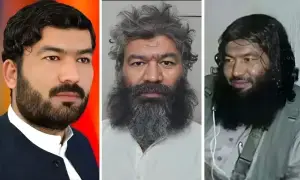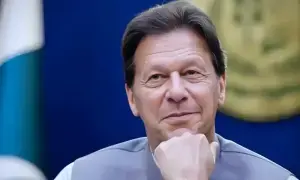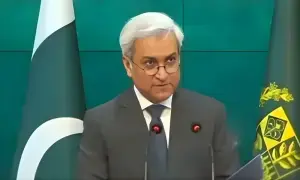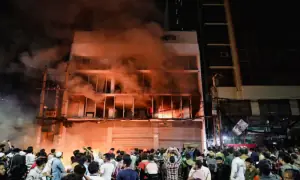Crazy, ugly beauty in ‘Mai Karachi’ exhibition captures Karachi’s paradox
Karachi will make you crazy and yet there will come a point when you realise the chaos and ugliness has its own beauty. A hard beauty that is even harder to love. You know, like some French bulldogs who are so ugly they are beautiful?
An exhibition at TDF Ghar captures this paradox with artists who have wrestled with this problem. Curator for the Mai Karachi Festival, Beenish Sarfaraz, said that the idea was to create an exploration into what the city holds, stores, hides or shares.
“By sensitizing the viewer and making them a part of the process with creative prompts and a little bit of oddity, we hoped to add to the experience of our existence - making it more expansive, more heart-led,” she added.
The works are a community-based collaboration with local artists, cultural actors, and students who wanted to explore and document the cultural spaces and dynamics of the city. “The Mai Karachi Project started when I moved to Karachi in 2018 and wanted to re-explore the city I call home, looking for beauty in the most unexpected places,” artist Habib Ahmed Asfar added by way of explanation.
Photo display ‘Locating contradictions’ by Wara Irfan, for example, poses the question of who has the right to the city in a place that seems to belong to everyone and no one at the same time. Each photograph shows a subject holding a piece of cardboard with the words ’Meri Jagh kahan hai“ (Where is my place?).


A flower power series by artist Habib Afsar and photographed by Najam ul Hassan and Luluwa Lokhandwala reminds us about resilience. “Crossing the gate into a military establishment, I was struck by a small flower growing through the concrete just where a huge metallic barrier and an angry-looking soldier stopped me for interrogation,” said Habib Afsar.
“Aware of my personal discomfort, I thought it was such a brave flower to flourish in such difficult circumstances. My friend Najam clicked a picture of it for me and that started our search for flowers growing in difficult places all over the city – an apt metaphor for resilience and courage.”
Habib Asfar is thus most interested in the social aspects of well-being. “My work, whether it is health, education, or culture is based on creating safe spaces where beauty is celebrated.”


Embroidering the flowers was a way to honor them and allowed for a meditative aspect of the work, he said. “Living in this city is not easy, and yet many, if not most of us, manage to flourish in our own ways.”
Luluwa and Habib also worked on an interactive piece called ‘Spin a story.’
The artists visited neglected grass-roots communities and had people develop itineraries for travelers to their areas. They realized that a better way to remember a location is by pegging it to a story. “We, therefore, collected real-life stories related to specific locations in the city we had explored, sprinkled some magical realism in them, and created a game.”

The ‘Spin the story’ game asks you to spin a wooden wheel with numbers written in chalk. Once the wheel stops spinning, pick the card for your number and read the short story on it. The stories tell a tale of the beauty in the everyday life of Karachi.
The cards were illustrated by graphic designer Luluwa Lokhandwala. “I’m fascinated with the doors you find in Karachi, so I decided to illustrate one of the doors I found in my explorations of the city,” she said.

The Hawaee display by Curator Beenish Sarfaraz shows collages of Karachi inspired by its wall chalkings or graffiti with eccentric elements like a woman walking on top of a skyscraper or a cricket bat mid-air.


“For me, there’s no better way of knitting together the experience of living in Karachi than collages,” she said. “It’s maddening and surreal at the same time. Just when I lose hope in the city, something or the other happens which reminds me there’s still some beauty left to uncover.” In a way, she now has a sense of Karachi that she carries with her “everywhere and it’s naturally translated into everything that [she does], which is making sense of the chaos through finding a somewhat new order.”

One of the pages on the Mai Karachi website is inspired by Karachi’s walls and how they are a record of so many local expressions. “We opened a call for Karachi’ítes to send in their own stories, visuals, write-ups of Karachi and what emerged was photo series of the places in the city that people have loved, have lived or left.”

Beenish recently curated and designed a South Asian food and culture book called “Manachi” in collaboration with Manchester Museum, British Council, State Bank Museum, and the University of Karachi.
In the interactive Maps of Karachi project, visitors are asked to doodle on a page to find images and shapes, with a reminder to not think of anything specific and simply let their imagination take over. The participants are then asked to give their maps a voice and let them speak. “This is the imaginative voice of Karachi and it has a lot to say. But are we listening?” she said.

I.I. Chundrigar Road ki Numaish was conceptualized by Luluwa Lokhandwala and Fiha Gilani. “It’s a reimagining of I.I. Chundrigar Road as an art gallery, and all the spots we thought were special, we imagined them as an art installation. Then we gave them fictional stories and authors and had fun with that,” she explained. Luluwa also designed and published a short book of the fictional stories behind the art.

The Mai Karachi Exhibition is on till January 31, 2023, at TDF Ghar.
For the latest news, follow us on Twitter @Aaj_Urdu. We are also on Facebook, Instagram and YouTube.




















Comments are closed on this story.